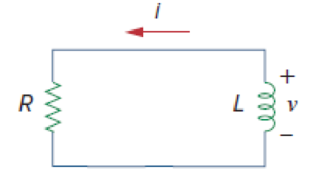
Concept explainers
For the circuit in Fig. 7.100,
v = 90e−50t V
and
i = 30e−50t A, t > 0
- (a) Find L and R.
- (b) Determine the time constant.
- (c) Calculate the initial energy in the inductor.
- (d) What fraction of the initial energy is dissipated in 10 ms?

Figure 7.100
(a)
Find the value of resistance R and inductance L in the Figure 7.100.
Answer to Problem 20P
The value of resistance R in the circuit is
Explanation of Solution
Given data:
The voltage
The current
Formula used:
Write the expression to find the voltage across the inductor for the given circuit.
Here,
L is the inductance of the inductor.
Write the expression to find the time constant for RL circuit.
Here,
R is the resistance of the resistor.
Write the general expression to find the voltage response in the RL Circuit.
Here,
Calculation:
Substitute
Rearrange the equation as follows,
Convert the unit H to mH.
Compare the given voltage
Rearrange the equation (4) to find the time constant
Substitute
Rearrange the equation (5) to find the resistance R in ohms.
Conclusion:
Thus, the value of resistance R in the circuit is
(b)
Find the time constant
Answer to Problem 20P
The time constant
Explanation of Solution
Given data:
Refer to part (a).
The value of resistance R is
The value of inductance L is
Calculation:
Substitute
Substitute the units
Convert the unit s to ms.
Conclusion:
Thus, the time constant
(c)
Find the value of initial energy stored in the inductor.
Answer to Problem 20P
The value of initial energy stored in the inductor is
Explanation of Solution
Given data:
Refer to part (a).
The value of inductance L is
Formula used:
Write the expression to find the energy stored in the inductor.
Here,
Calculation:
The given current is,
The initial current in the RL circuit at
Substitute
Conclusion:
Thus, the value of initial energy stored in the inductor is
(d)
Find the fraction of the energy dissipated in the first 10 ms.
Answer to Problem 20P
The fraction of the energy dissipated in the first 10 ms is
Explanation of Solution
Given data:
Refer to part (c).
The value of initial energy w stored in the inductor is
Formula used:
Write the expression to find the energy stored in the inductor.
Calculation:
The given current is,
The current in the RL circuit at
Substitute
The fraction of the energy dissipated in the first 10 ms is calculated as follows.
Substitute
Conclusion:
Thus, the fraction of the energy dissipated in the first 10 ms is
Want to see more full solutions like this?
Chapter 7 Solutions
EE 98: Fundamentals of Electrical Circuits - With Connect Access
- Two alternators, Y-connected 6.6 kV supply a load of 3000 kW at 0.8 p.f lagging. The synchronous mpedance of first alternator is (0.5+j10) Q/ph and second alternator is (0.4+j12) /ph. First alternator delivers 150 amp at 0.875 lag p.f. The two alterators are shared load equally. Determine the current, p.f., induced e.m.f, load angel, and maximum developed power of each alternator?arrow_forwardA domestic load of 2300 kW at 0.88 p.f lagging and a motors load of 3400 kW at 0.85 p.f lagging are supplied by two alternators operating in parallel. If one alternator is delivering a load of 3300 kW at 0.9 p.f lagging, what will be the output power and p.f of the other alternator?arrow_forwardDetermine the value of Rr that necessary for the circuit in Fig.(2) to operate as an oscillator and then determine the frequency of oscillation. 0.001 F 0.001 F 0.001 F R₁ • 10 ΚΩ R₁ 10 k R • 10 ΚΩarrow_forward
- (a) For the circuit shown in Figure Q3(a) (RFC and Cc are forbias) (i) (ii) Draw the AC small signal equivalent circuit of the oscillator. From this equivalent circuit derive an equation for fo and the gain condition for the oscillations to start. VDD www RG eee RFC H Cc 北 5 C₁ L 000 C₂ Voarrow_forwardPlease solve this question step by step handwritten solution and do not use chat gpt or any ai toolsfor part ii) you may need to use nodal analysisarrow_forward12.1. Find the steady-state response vo (t) for the network. 00000- 1Ω ww 12 cos(t) V + www 202 1 H 202 1 F + 1Ω νο -arrow_forward
- A Three-phase, 12 pole, Y-connected alternator has 108 slots and 14 conductors per slot. The windings are (5/6 th) pitched. The flux per pole is 57 mWb distributed sinusoidally over the pole. If the machine runs at 500 r.p.m., determine the following: (a) The frequency of the generated e.m.f., (b) The distribution factor, (c) The pitch factor, and (d) The phase and line values of the generated e.m.f.?arrow_forwardTwo 3-ph, 6.6 kV, Y-connected, alternators supply a load of 3000 kW at 0.8 p.f. lagging. The synchronou impedance per phase of machine A is (0.5+110) and that of machine B is (0.4 +J12) . The excitation of machine A adjusted so that it delivers 150 A. The load is shared equally between the machines. Determine the armature curre p.f., induced e.m.f., and load angle of each machine?arrow_forwardName the circuit below? The output voltage is initially zero and the pulse width is 200 μs. Find the Vout and draw the output waveform? +2.5 V V 247 -2.5 V C 0.01 F Ri W 10 ΚΩarrow_forward
- Please work outarrow_forwardFind Vfinal when Vs up and Vs V. Which LED will light in each case? Red or Green? Justify your answers. Fill the table below. Vs 8 ΚΩ Vos Χρι + 3 ΚΩ www 6 ΚΩ ww 4 ΚΩ Yo www Vo Vec-12 V Nol V final Vm w 3 ΚΩ 5 V 38 ΚΩ R= 1 kQ V -12 V Red LED Green LED Vs Vo Vfinal Which LED is ON? Varrow_forwardCircuits help please solve and explain. Question in images providedarrow_forward
 Delmar's Standard Textbook Of ElectricityElectrical EngineeringISBN:9781337900348Author:Stephen L. HermanPublisher:Cengage Learning
Delmar's Standard Textbook Of ElectricityElectrical EngineeringISBN:9781337900348Author:Stephen L. HermanPublisher:Cengage Learning
